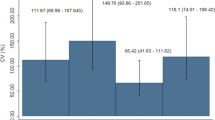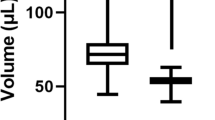ABSTRACT
Purpose
Evaluation of product viscosity, density and aeration on the dose delivery and accuracy for intravitreal injections with commonly used commercially available hypodermic 1 mL syringes.
Methods
Six commercially available hypodermic 1 mL syringes with different specifications were used for the study. Syringes were filled with the test solutions with different densities and viscosities. Syringes were also subjected to shaking stress to introduce aeration in the test solutions in the presence of different surfactant concentrations with and without high antibody concentration. Target intravitreal volumes of 100 μL, 50 μL and 30 μL were tested to assess dosing accuracy in a controlled simulated administration setup using DIN ISO 11040-4 guidelines and Zwick/Roell Z010 TN instrument.
Results
With increasing product viscosity, higher volumes and hence doses were delivered especially for very low volumes like 50 μL and 30 μL. No impact of increasing product density was found on the delivered dose. The presence of surfactants or high protein concentration can lead to aeration, which also negatively affects the dose accuracy and precision.
Conclusion
Formulation parameters like viscosity can have an impact on dose delivery using hypodermic syringes for intravitreal injections and on the resulting glide force.







Similar content being viewed by others
Abbreviations
- IVT:
-
intravitreal
- PFS:
-
prefilled syringe
- PS20:
-
Polysorbate20
- PS:
-
Polysorbate
- mAb:
-
monoclonal antibody
REFERENCES
Avery RL, Bakri SJ, Blumenkranz MS, Brucker AJ, Cunningham ETJ, D'Amico DJ, et al. Intravitreal Injection Technique and Monitoring: Updated Guidelines of an Expert Panel. Retina. 2014;34:S1–S18.
Gaudana R, Ananthula HK, Parenky A, Mitra AK. Ocular drug delivery. AAPS J. 2010;12(3):348–60.
Thrimawithana TR, Young S, Bunt CR, Green C, Alany RG. Drug delivery to the posterior segment of the eye. Drug Discov Today. 2011;16(5-6):270–7.
Jager RD, Aiello LP, Patel SC, ETJ C. RISK OF INTRAVITREOUS INJECTION: A COMPREHENSIVE REVIEW. Retina. 2004;25(5):676–98.
Meyer CH, Liu Z, Brinkmann C, Rodrigues EB, Helb HM. Accuracy, precision and repeatability in preparing the intravitreal dose with a 1.0-cc syringe. Acta Ophthalmol. 2012;90(2):e165–6.
Raju JR, Weinberg DV. Accuracy and Precision of Intraocular Injection Volume. Am J Ophthalmol. 2002;113(4):564–6.
Thobani SU, Steward DJ. The accuracy and variability of bolus injections with different sized syringes. Can J Anaesth. 1992;39(2):198–201.
Lee SN, Wong AH, Mayer A, Walker SE. Accuracy and reproducibility of syringe measurements. Am J Health-Sys Pharm. 1996;53(10):1166–9.
Erstad AJ, Erstad BL, Nix DE. Accuracy and reproducibility of small-volume injections from various-sized syringes. Am J Health Syst Pharm. 2006;63(8):748–50.
Gerding H, Timmermann M. Accuracy and precision of intravitreally injected ranibizumab doses: an experimental study. Klin Monbl Augenheilkd. 2010;227(4):269–72.
Gnanalingham MG, Newland P, Smith CP. Accuracy and reproducibility of low dose insulin administration using pen-injectors and syringes. Arch Dis Child. 1998;79(1):59–62.
Moisseiev E, Rudell J, Tieu EV, Yiu G. Effect of Syringe Design on the Accuracy and Precision of Intravitreal Injections of Anti-VEGF Agents. Curr Eye Res. 2017;42(7):1059–63.
Patel S, Stracke JO, Altenburger U, Mahler HC, Metzger P, Shende P, et al. Prediction of intraocular antibody drug stability using ex-vivo ocular model. Eur J Pharm Biopharm. 2017;112:177–86.
ISO 7886-1:2017(E) Sterile hypodermic syringes for single use. 2017.
De Stefano VS, Abechain JJ, de Almeida LF, Verginassi DM, Rodrigues EB, Freymuller E, et al. Experimental investigation of needles, syringes and techniques for intravitreal injections. Clin Exp Ophthalmol. 2011;39(3):236–42.
Raut AS, Kalonia DS. Opalescence in Monoclonal Antibody Solutions and Its Correlation with Intermolecular Interactions in Dilute and Concentrated Solutions. Journal of Pharmaceutical Sciences. 2015;104(4):1263–74.
Sampat KM, Wolfe JD, Shah MK, Garg SJ. Accuracy and Reproducibility of Seven Brands of Small-Volume Syringes Used for Intraocular Drug Delivery. Ophthalmic Surg Lasers Imaging Retina. 2013;44:385–9.
Gerhardt A, Nguyen BH, Lewus R, Carpenter JF, Randolph TW. Effect of the siliconization method on particle generation in a monoclonal antibody formulation in pre-filled syringes. J Pharm Sci. 2015;104(5):1601–9.
Pelaez S, Mahler HC, Koulov A, Joerg S, Matter A, Vogt M, Chalus P, Zaeh M, Sediq A, Jere D, Mathaes R. Characterization of Polymeric Syringes Used for Intravitreal Injection. J Pharm Sci. In Press, 11 June 2020.
ACKNOWLEDGMENTS
The authors want to thank Pascal Chalus from Drug Product Services at Lonza AG in Basel for his support taking the microscope pictures of the syringes.
Author information
Authors and Affiliations
Corresponding author
Additional information
Publisher’s Note
Springer Nature remains neutral with regard to jurisdictional claims in published maps and institutional affiliations.
Electronic supplementary material
ESM 1
(DOCX 4351 kb)
Rights and permissions
About this article
Cite this article
Weinmann, C., Sediq, A.S., Vogt, M. et al. Role of Formulation Parameters on Intravitreal Dosing Accuracy Using 1 mL Hypodermic Syringes. Pharm Res 37, 190 (2020). https://doi.org/10.1007/s11095-020-02880-2
Received:
Accepted:
Published:
DOI: https://doi.org/10.1007/s11095-020-02880-2




